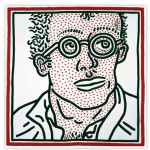Visual AIDS’ upcoming public program Curating Queer Black Legacies: Ajamu and Sur Rodney (Sur) in conversation on March 23 will highlight Visual AIDS / Residency Unlimited Curatorial Resident Ajamu’s photography and archival curatorial practice. The event will take place at 6:30 at Syracuse University’s Lubin House in New York City, which is currently displaying a retrospective exhibition of renowned photographer Rotimi Fani-Kayode, a friend and inspiration for Ajamu’s work. In this interview between Syracuse University’s Light Work Director Shane Lavalette and Visual AIDS former intern Maia Paroginog, the pair consider Fani-Kayode’s important photography and legacy.
Fani-Kayode was a seminal figure in 1980s black British and African contemporary art whose timeless photographs constitute a profoundly personal and political exploration of complex notions of desire, diaspora, and spirituality. A son of a prominent Yoruba family who left Africa as political refugees in 1966, Fani-Kayode received a BA at Georgetown University in Washington, DC in 1980, and an MFA at Pratt Institute in New York in 1983, before returning to the United Kingdom where he lived and worked until his death in 1989. In his portraits, the black male body becomes the focal point of a photographic inquiry to imaginatively interpret the boundaries between spiritual and erotic fantasy, cultural and sexual difference. Ancestral rituals and a provocative, multi-layered symbolism fuse with archetypal motifs from European and African cultures and subcultures – inspired by what Yoruba priests call ‘the technique of ecstasy’.
Read the New Yorker review of Rotimi Fani-Kayode’s retrospective here.
Maia Paroginog: What prompted the Rotimi Fani-Kayode retrospective? How was the show organized?
Shane Lavalette: We have a longstanding relationship of working with Autograph ABP in London, which Rotimi was a co-founder of. Autograph represents Rotimi’s work and his legacy, and we thought it would be a really great collaboration with them, and a nice opportunity to gain more exposure in America for his important work. We are working with Syracuse Unversity’s Traveling Exhibition Program to extend the reach of the show.
MP: Rotimi’s photographs incorporate his Nigerian roots and use the black male body as a point of creative departure. What types of conversations do you want to see around Rotimi’s work?
SL: Rotimi’s work was significant at the time that he made it but the types of conversations he hoped to spark are equally timely now. The work sparks conversations about representation of the black body, vulnerability, sexuality, desire, love, politics of place, and much more.
MP: Did Rotimi’s HIV status impact his photography? How does it affect the way his work is received, disseminated, and collected today?
SL: It seems to me that Rotimi’s life is so much a part of his work, so naturally I think the answer is yes. There are certainly many exhibitions and publications that might frame his images through that lens—however, his oeuvre can equally stand on its own, images that speak about struggle, desire, and strength.
MP: This retrospective arrives at a critical political moment, with the introduction of anti-gay laws in Nigeria and various African countries. How does the work function as a political statement?
SL: It goes to show that there have been a lot of positive changes in the world while at the same time there is much more progress to be made. Rotimi’s work as an inspiration to many of today’s artists who are engaged in similar topics and look to his work as paving the way for them.
MP: Zanele Muholi held a residency during the run of the exhibit in Syracuse. What connection exists between today’s generation of African artist- activists and Rotimi’s legacy?
SL: Perfect example. Zanele was ecstatic to discover Rotimi’s work in the gallery while she was here in Syracuse. As she put it, she felt she simply couldn’t be who she is now and doing what she is doing now if it weren’t for his contributions.
MP: Rotimi is quoted as saying: "…It is photography, therefore–Black, African, homosexual photography—which I must use not just as an instrument, but as a weapon if I am to resist attacks on my integrity and, indeed, my existence on my own terms." Can you speak about “the preservation of integrity” in Rotimi’s photographs?
SL: At a time where the world was becoming more image saturated and conscious, many cultures or individuals were omitted from those representations, cast aside. I imagine Rotimi felt that way, and indeed Zanele is fighting against this still. Placing themselves and their community in that stream of images, through their art, is a powerful action. For Rotimi, it was a way to fight back against a world that didn’t accept him, a “weapon.”
Shane Lavalette is the director of Light Work, a non-profit photography organization located in Syraucse, NY. Light Work exhibited the work of Rotimi Fani-Kayode in the Fall of 2015 and traveled the exhibition to the Palitz Gallery at the Lubin House in NYC in Winter/Spring 2016.
Maia Paroginog is a former intern at Visual AIDS who is in their final undergraduate year at Stanford with focuses in visual art making, arts writing, and comparative studies in race and ethnicity. Their work employs several mediums and representations, which range from abstract sculpture to figurative painting. Their artwork and academic interests revolve around bodily dysphoria, queering interpersonal relationships, intersectional feminism, power/privilege, and the abject abstract. They use queer art to interrogate notions of “identity” and are interested in its uses in addressing collective trauma.

















Comments
Comments